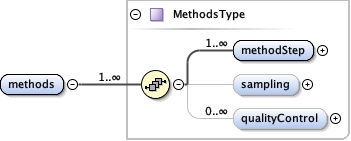<xs:complexType name="MethodsType">
<xs:sequence maxOccurs="unbounded">
<xs:element name="methodStep" maxOccurs="unbounded">
<xs:annotation>
<xs:documentation>tooltip: method information summary: Information about the methods employed in collecting or generating a data set or other resource. description: The methodStep field allows for repeated sets of elements that document a series of procedures followed to produce a data object. These include text descriptions of the procedures, relevant literature, software, instrumentation, source data and any quality control measures taken.</xs:documentation>
</xs:annotation>
<xs:complexType>
<xs:complexContent>
<xs:extension base="ProcedureStepType">
<xs:sequence>
<xs:element name="dataSource" type="ds:DatasetType" minOccurs="0" maxOccurs="unbounded">
<xs:annotation>
<xs:documentation>tooltip: data source summary: A source of data used by this methodStep. description: A source of data used by this methodStep.</xs:documentation>
</xs:annotation>
</xs:element>
</xs:sequence>
</xs:extension>
</xs:complexContent>
</xs:complexType>
</xs:element>
<xs:element name="sampling" minOccurs="0">
<xs:annotation>
<xs:documentation>tooltip: sampling methods summary: Description of sampling procedures including the geographic, temporal and taxonomic coverage of the study. description: Description of sampling procedures including the geographic, temporal and taxonomic coverage of the study. See individual elements for more detailed descriptions.</xs:documentation>
</xs:annotation>
<xs:complexType>
<xs:sequence>
<xs:element name="studyExtent">
<xs:annotation>
<xs:documentation>tooltip: Geographic, temporal, taxonomic coverage summary: A description of the geographic area sampled (geographic coverage), the sampling frequency (temporal coverage), and living organisms sampled (taxonomic coverage. description: The field studyExtent represents both a specific sampling area and the sampling frequency (temporal boundaries, frequency of occurrence). The geographic studyExtent is usually a surrogate (representative area of) for the larger area documented in the "studyAreaDescription". The studyExtent can be entered either in non-structured textual form or using the structure of the coverage element.</xs:documentation>
</xs:annotation>
<xs:complexType>
<xs:choice maxOccurs="unbounded">
<xs:element name="coverage" type="cov:Coverage">
<xs:annotation>
<xs:documentation>tooltip: coverage summary: A description of the geographic area sampled (geographic coverage), the sampling frequency (temporal coverage), and living organisms sampled (taxonomic coverage. description: The field studyExtent represents both a specific sampling area and the sampling frequency (temporal boundaries, frequency of occurrence). The geographic studyExtent is usually a surrogate (representative area of) for the larger area documented in the "studyAreaDescription". The studyExtent can be entered either in non-structured textual form or using the structure of the coverage element. See eml-coverage for more information.</xs:documentation>
</xs:annotation>
</xs:element>
<xs:element name="description" type="txt:TextType">
<xs:annotation>
<xs:documentation>tooltip: Text description of the coverage summary: A textual description of the specific areas sampled (geographic coverage), the sampling frequency (temporal coverage), and groups of living organisms sampled (taxonomic coverage). description: The coverage field allows for a textual description of the specific sampling area, the sampling frequency (temporal boundaries, frequency of occurrence), and groups of living organisms sampled (taxonomic coverage).</xs:documentation>
</xs:annotation>
</xs:element>
</xs:choice>
</xs:complexType>
</xs:element>
<xs:element name="samplingDescription" type="txt:TextType">
<xs:annotation>
<xs:documentation>tooltip: Sampling methods and procedures summary: A description of sampling methods and procedures description: The samplingDescription field allows for a text-based/human readable description of the sampling procedures used in the research project. The content of this element would be similar to a description of sampling procedures found in the methods section of a journal article.</xs:documentation>
</xs:annotation>
</xs:element>
<xs:element name="spatialSamplingUnits" minOccurs="0">
<xs:annotation>
<xs:documentation>tooltip: Spatial sampling units summary: Spatial sampling units represent the plots sampled. description: A spatial sampling unit describes the specific geographic areas sampled. In the case of a study in which the measurements from several disbursed point collection devices are aggregated, then the sampling unit would be the area of that aggregation. Spatial sampling units can either be described by filling out the structured coverage element or by reference to the values in a data table (usually a GIS layer)</xs:documentation>
</xs:annotation>
<xs:complexType>
<xs:choice maxOccurs="unbounded">
<xs:element name="referencedEntityId">
<xs:annotation>
<xs:documentation>tooltip: The identifier of a spatial sampling entity. summary: The identifier of an entity described in the entity module. This is usually a GIS layer. description: A value of a referencedEntityId element is a reference to the identifier of the entity module that provides the metadata for a data table (RDBMS, GIS or ascii text) that has the actual spatial sampling unit values. The referencedEntityId field is an indirect pointer to the actual values. The referencedEntityId can be thought of as a foreign key in a relational database.</xs:documentation>
</xs:annotation>
</xs:element>
<xs:element name="coverage" type="cov:GeographicCoverage">
<xs:annotation>
<xs:documentation>tooltip: sampling unit location summary: Structured description of each sampling unit location description: Structured description of each sampling unit location</xs:documentation>
</xs:annotation>
</xs:element>
</xs:choice>
</xs:complexType>
</xs:element>
<xs:element name="citation" type="cit:CitationType" minOccurs="0" maxOccurs="unbounded">
<xs:annotation>
<xs:documentation>tooltip: citation summary: Literature citation relating to the sampling procedures used. description: The citation field allows to either reference a literature resource or enter structured literature information</xs:documentation>
</xs:annotation>
</xs:element>
</xs:sequence>
</xs:complexType>
</xs:element>
<xs:element name="qualityControl" type="ProcedureStepType" minOccurs="0" maxOccurs="unbounded">
<xs:annotation>
<xs:documentation>tooltip: Quality Control summary: Information on possible errors or on the quality of a data set. description: The qualityControl field provides a location for the description of actions taken to either control or assess the quality of data resulting from the associated method step. A quality control description should identify a quality goal and describe prescriptive steps taken to ensure that the data meet those standards and/or postscriptive steps taken to assess the extent to which they are met. A quality control statement is associated with the methodStep that could have affected the targeted quality goal.</xs:documentation>
</xs:annotation>
</xs:element>
</xs:sequence>
</xs:complexType> |


